
Debit card use can get tricky outside the U.S. If your card is backed by a major company like VISA or Mastercard, it will be accepted at millions of locations. However, it's easy to rack up fees if you're not paying attention, and if you don't call your bank ahead of time, the bank may freeze your account for suspicious activity. A debit card is a great alternative to carrying large sums of money because if the card is stolen, you can quickly cancel it. However, when traveling, it's best to have more than one form of payment available.
Before You Leave
Call your bank. Let it know where and when you'll be traveling so that it can make a note in its system. Charges from unusual locations often set off red flags with financial institutions and may cause the bank to freeze your accounts. Ask the bank about any fees associated with using your debit card internationally. Also ask what you can do to minimize these costs. Check with your bank about any daily limits it may have on spending or withdrawals in foreign countries.
Make a list of important numbers. This should include the international phone number for your bank in case you need to reach it. You also need the number to call in case your card is stolen or misplaced. Memorize the personal identification number you use to access your account at an ATM. You'll need your PIN to access ATMs, but for security, you should never write this number down anywhere.
Make a list of places you can use your debit card at an ATM for free. If your bank is part of a network, often you can use ATMs run by other banks in its network for free, even if you're in another country. Call your bank to find out if it is part of a network by calling it. Pull up a map of where you'll be visiting and write down directions to the nearest free ATM.
Research fees. Not only can you rack up fees of $2 to $5 per transaction at an ATM if it's not in your bank's network, you can also be charged a foreign transaction fee. Generally, this fee is between 1 and 3 percent. When you use your card at a retailer, you may be charged a conversion fee by your bank, usually between 1 and 3 percent. You may also be charged a fee by the retailer. Be informed before you leave.
Using Your Card
Minimize your debit card use while abroad. The more you use your card, the more fees you'll rack up. At ATMs, avoid frequent withdraws of small amounts of money.
Decline currency conversion at retailers. When you use your debit card for a purchase in another country, you pay for the item in that country's currency. However, the charge that shows up on your statement will be in U.S. dollars. If the store asks you if you would like to pay in U.S. dollars on your debit card, decline. In-store currency conversion can be very costly. Usually it's better to let your bank do the work.
Calculate your purchase in U.S. dollars and write it on your receipt. You can later check this against your bank statement to make sure there aren't any glaring errors.
If your card is declined, call your bank. Even if you called the bank before you left, you may need to authorize a purchase, especially if it's large.
Tips
Keep your debit card in a safe place, and don't withdraw extremely large amounts of money.
Immediately report lost or stolen cards to your debit card issuer.
Warnings
Some U.S. banks use PINs longer than four digits, which may not be accepted abroad. You may need to call your bank and arrange to change your PIN to a four-digit number.
References
- Bank of America: How to Pay When You're Traveling Abroad
- ABC News: Four Common International Travel Fees and How to Avoid Them
- Visa. "Plus and Plus Alliance ATM Finder Networks." Accessed July 20, 2020.
- Mastercard. "Learn More About Our Brands." Accessed July 20, 2020.
- United States Department of State Diplomatic Security. "Taking Credit," Page 2. Accessed July 20, 2020.
- Office of the New York City Comptroller. "Take It To The Bank," Accessed July 20, 2020.
- Visa. "How to Use an ATM Overseas." Accessed July 20, 2020.
- The Ohio State University. "How Economics Helps You Save Money When Traveling Internationally." Accessed July 20, 2020.
- Federal Trade Commission Consumer Information. "Lost or Stolen Credit, ATM, and Debit Cards." Accessed July 20, 2020.
Tips
- Keep your debit card in a safe place, and don't withdraw extremely large amounts of money.
- Immediately report lost or stolen cards to your debit card issuer.
Warnings
- Some U.S. banks use PINs longer than four digits, which may not be accepted abroad. You may need to call your bank and arrange to change your PIN to a four-digit number.
Writer Bio
Specializing in food and business, Melissa Haskin is a Oregon writer who received a Bachelor of Science in economics with an emphasis in business from Oregon State University. She completed graduate work in journalism at the University of Oregon and has contributed to publications such as "The Register-Guard," "Oregon Quarterly" and "Eugene Magazine."

